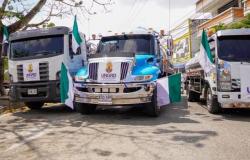Salesian Natalio Astolfo, Gendarmerie chaplain, ran towards the jeep that arrived at the Puerto Argentino hospital. When he barely saw Vizoso Posse31 years old, on one of the stretchers, took him by the hand and repeated that God was with him and that the Virgin loved him very much.
Jorge Manuel Vizoso Posse was born in San Miguel de Tucumán on March 8, 1951. As a first lieutenant, during the Malvinas War, he joined the 602 Commando Companyled by Major Aldo Rico.
On June 9, the commandos decided to ambush the British in a position located in front of Mount Two Sisters, near the Murrell River. Due to the shortage of men at that point in the conflict, companies 601 and 602, both from the Army, joined with the Alacran Squadron, from the Gendarmerie.
In two Land Rovers they were taken, in the middle of a dense fog, to the positions of Lieutenant Colonel Soria, head of the 4th Infantry Regiment. In Monte Dos Hermanas they found Second Lieutenant Marcelo Llambías, who with twenty soldiers and half a dozen corporals were the most advanced of the unit, and those who had more work, since they had to repel one after another incursions by the British who wanted to know the Argentine defensive apparatus. When Rico studied the place, he decided to return the next day.
In the arrangement that had been decided on the night of June 9, it was established that one of the machine guns would be in charge of First Lieutenant Enrique Rivas and First Sergeant Orlando Aguirre and another with First Lieutenant Jorge Vizoso Posseas prompter and sergeant Mario Cisnero as a supplier.
Both machine guns, separated by about forty meters, were about fifteen in front of the position of the rest of the commandos, arranged on the assault, support and reception echelons. Among them, medical captain Hugo Ranieri, who had been designated as a sniper.
Vizoso Posse and Cisnero They sat back to back to have a complete vision. The first one broke a chocolate bar that he kept as a treasure in half and shared it.
Around two in the morning, from the right, they saw eight British approaching, who were part of an advance party. Cisnero, who had previously asked Vizoso Posse to take charge of the MAG, opened fire. The British responded with a 66mm Law rocket, which hit the sergeant in the chest, sending them both flying, and destroying the machine gun.
Vizoso Posse saw that Cisnero was dead, and He saw that the enemy was approaching. He had injuries to his shoulder blade, caused by shrapnel from the explosion.
He was clear that he was neither going to surrender nor be taken prisoner.. He pretended to be dead. He perceived that two British were behind him. One of them, even though Cisnero was lifeless, shot him. The other kicked Vizoso’s foot, he shot a burst and only one projectile hit his right shoulder; He could see how the bullets raised stones and dust very close to his face. With a strong kick to his right leg, she left him looking at the sky. Vizoso, holding his breath, he remained with his eyes open.
Rico could be heard calling Cisnero insistently.
When the English retraced their steps, Vizoso Posse stood up, looked for his rifle and shot them. When he emptied his magazine, he took his sergeant’s magazine and fired again. He saw some fall. At that precise moment, the rest of the commandos opened fire, unleashing all hell.
A bazooka projectile ended the life of the assistant sergeant Ramon Gumersindo Acostafrom the Alacran Squadron.
Despite the shots he received and the shrapnel in his back, Vizoso Posse had gotten up and He returned to where his companions were with the intention of fighting, and they ordered him to go to Ranieri to cure him.
“How am I? “Can I continue?” she asked. The doctor told him that he had a big hole in his back but to take the rifle and shoot. He keenly saw that about forty meters away an Englishman wanted to target him and managed to shoot him down.
There was an intense exchange of rifle, grenade and machine gun fire., which lasted about half an hour, during which the enemy launched luminous flares that slowly descended by parachute. Both sides believed they were facing larger forces, until they realized that they were not regular troops, but rather commandos.
From above, they were supported by a machine gun from the 4th regiment.
Major Aldo Rico told First Lieutenant Enrique Stel, the officer in charge of communications, to give the coordinates to the artillery to hit the area. Some of the officers did not want to leave the field; For many it was their baptism of fire and they felt that they had the British under control and that they had to be pursued. However, Rico knew that the English would also call in his artillery, which happened.
When the artillery made itself felt, the ground shook and the shock waves were clearly perceived. Rico himself gave the coordinates to the battery commanded by Balza so that the shots could fall on the retreat of the British. “How are we doing?” Stel asked Rico. “Perro Cisnero and Gendarme Acosta died; Vizoso and the gendarme Parada are injured and we take them to the hospital. Call and have them send us an ambulance.”
Vizoso received the first cures from First Lieutenant Oneto because Ranieri was still on the ground fighting. They didn’t believe him when he said that they had shot him to finish him off.
He marched alongside the others, warning that he would walk as far as he had the strength, until he was picked up by a vehicle that took him to Puerto Argentino, where he arrived at nine in the morning on the 10th along with his exhausted companions. On his back he had a 15 centimeter wound with an exit hole about five centimeters long through his neck.. The projectile they shot at him was tracer and because of the phosphorus it contained, it helped to cauterize the wound and prevented the bleeding from being large.
They put him in a wheelchair, when he saw himself in a mirror he couldn’t recognize himself because he was so pale and he fainted. They claim that the operation was very complicated, he had lost a lot of blood and the anesthesia had not taken long enough.
The curious thing was that the projectile, which came out of the neck with little force, remained near his left collarbone. One of the plastic Rosary beads that all the soldiers wore around their necks was melted.
For Vizoso Posse that day the war ended. He recomposed himself and again wearing his combat uniform helped embark the wounded from the 7th regiment on the last Hercules that was able to return to the continent. He himself was forced to go up.
He was decorated with the Cross “For Heroic Valor” and remained in the Army until 1993, when he retired with the rank of major. “The Yankee,” as he had been nicknamed because of his aversion to anything American, dedicated himself to various jobs in private life.
Devotee of the Virgin of the Valley, what an anti-tank missile or a tracer bullet could not achieve, a heart attack could. On March 8 he had turned 73 years old. He was married to María del Huerto Eloísa Pinto, his longtime girlfriend, and they had five children, María Guadalupe, María Constanza, Jesús Manuel, María del Rosario and María de los Milagros.
He will be buried tomorrow, Tuesday, in the Peace Park, in his native province, with military honors.
As he was able to be transferred to the mainland hours before the ceasefire, he always clarified with pride that, as had happened that morning in Cerro Dos Hermanas, he had never surrendered.
Sources: Interviews with Horacio Lauría and Andrés Ferraro; Commandos in Action, by Isidoro J. Ruiz Moreno;






